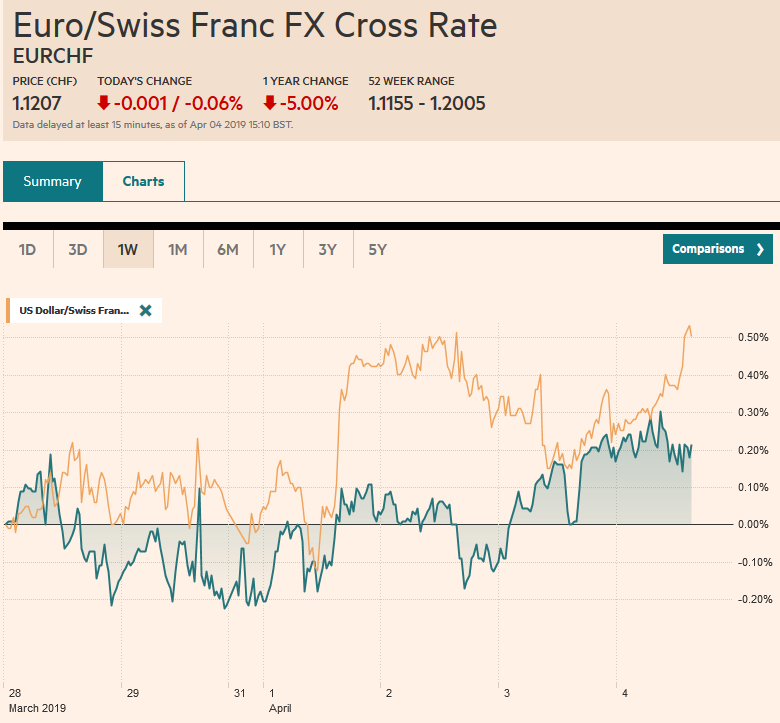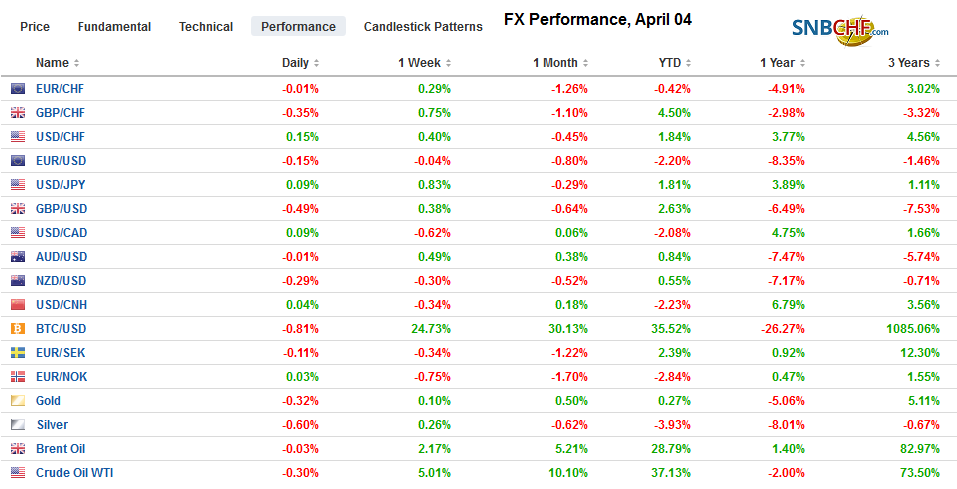Swiss Franc The Euro has fallen by 0.06% at 1.1207 EUR/CHF and USD/CHF, April 04(see more posts on EUR/CHF, USD/CHF, ) Source: markets.ft.com - Click to enlarge FX Rates Overview: The global capital markets are subdued despite several macro developments. The US and China may announce as early as today when the two presidents will meet to ostensibly sign a trade deal, while House of Commons effort to block a no-deal exit goes to the House of Lords today. India cut interest rates by 25 bp, the second consecutive cut. German factory orders slumped 4.2% in February, the most in two years. Equities were mixed in Asia, and the Dow Jones Stoxx 600 is snapping a four-day advance. US shares are trading softer, and the
Topics:
Marc Chandler considers the following as important: 4) FX Trends, Brexit, China, Featured, newsletter, USD
This could be interesting, too:
Nachrichten Ticker - www.finanzen.ch writes Die Performance der Kryptowährungen in KW 9: Das hat sich bei Bitcoin, Ether & Co. getan
Nachrichten Ticker - www.finanzen.ch writes Wer verbirgt sich hinter der Ethereum-Technologie?
Martin Hartmann writes Eine Analyse nach den Lehren von Milton Friedman
Marc Chandler writes March 2025 Monthly
Swiss FrancThe Euro has fallen by 0.06% at 1.1207 |
EUR/CHF and USD/CHF, April 04(see more posts on EUR/CHF, USD/CHF, ) Source: markets.ft.com - Click to enlarge |
FX RatesOverview: The global capital markets are subdued despite several macro developments. The US and China may announce as early as today when the two presidents will meet to ostensibly sign a trade deal, while House of Commons effort to block a no-deal exit goes to the House of Lords today. India cut interest rates by 25 bp, the second consecutive cut. German factory orders slumped 4.2% in February, the most in two years. Equities were mixed in Asia, and the Dow Jones Stoxx 600 is snapping a four-day advance. US shares are trading softer, and the S&P 500 has a five-day rally in tow, reaching new six-month highs yesterday. Bond yields are mostly softer, though Australia and New Zealand were outliers in the Asia Pacific, and Italy is an exception in Europe. Yesterday the 10-year Bund yield rose above zero for the first time in a week, but after the factory orders disappointed is back in negative territory. The dollar is little changed, though generally firmer. Late in the European morning, most of the major currencies are +/- 0.15% from yesterday’s US close. |
FX Performance, April 04 |
Asia Pacific
China and the US may announce a meeting for Xi and Trump to meet and sign a new agreement. In fact, if an announcement is not made today, the disappointment may way on the capital markets. According to reports, China will have until 2025 to meet the commitment to commodity purchases and allow US businesses to own wholly owned subsidiaries in China. The US is pushing to front-load commodity purchases with benchmark objectives for 90 and 180 days. There are said to be some other non-binding promises to be delivered by 2029, but there is no threat of retaliation if the goals are not met, until the 2025 deadline, for which the US retains the right for proportionate tariff action. China has been reluctant to agree not to retaliate but seems to be taking it under advisement. Reports. The pending agreement seems to do two things. First, get it done before the US sells fighter jets to Taiwan. Second, shape the timeframe to be most useful to the next president, apparently on ideas that Trump will be re-elected.
There are three issues that we cite now that we will write about in more detail later. First, the commodity purchases sound good for US farmers and the energy producers. However, this is low value-added sectors and seems to do little for US manufacturers. China gets secures soy and energy inputs. Second, the US is setting a dangerous precedent by seeking a sphere of influence in China. It is not seeking a lifting of barriers to trade for everyone, allowing the US to compete on a level playing field, which had previously been its thrust. Just as the Belt-Road Initiative is in some ways reminiscent of earlier expansions by the European powers and the US, the shift back to spheres of influence is a retreat from the Open Door, a mainstay of US foreign economic policy since the start of the 20th century, and globalized in the post-WWII institutions, like GATT (WTO), World Bank and IMF. Third, the US devalued the dollar, by getting Europe (Germany) and Japan to revalue their currencies (the 1960s through 1980s), but America’s fear of a devaluation of the yuan is so great that it does not seem to realize that yuan stability is a double-edged sword. It will make it more difficult for the US to seek a weaker dollar against the yuan. Promising a stable yuan allows China to erode any advantage of a weaker dollar.
India cut its repo and reserve repo rates 25 bp to 6.0% and 5.75% respectively. It kept the cash reserve rate at 4.0%. It is the first back-to-back cut since the monetary policy committee was launched in 2016. While headline inflation is below the RBI’s Q1 forecast of 2.8% and below the 4% target, the core rate is at 5%. Indian banks have not fully passed along the first rate cut, but many see the rate cut as political motivated ahead of the month-long election that begins next week. Still, many look for another cut toward the end of Q2.
For the third session, the dollar is trapped in extremely narrow ranges against the yen. On Tuesday, the range was 21 ticks, yesterday 37, and so far today, 18. The dollar is hovering near the JPY111.50 level, where options for almost $970 mln are struck that will be cut today. For the fourth session, the Australian dollar has met a wall of sellers near $0.7130. Australian stocks and bonds are underperformed today, but the Aussie remains resilient and is holding on to most of the gains since testing the $0.7050 area over the past two sessions. There is an option for A$1.6 bln struck at $0.7100 that expires tomorrow.
Europe
By a single vote, the House of Commons blocked a no-deal exit. The bill now goes before the House of Lords, which is a touch ironic, given the UK criticism of the being at the mercy of the non-elected European Commission. If a no-deal exit is effectively blocked by required May to seek another extension, then the Withdrawal Bill may find more support, if it can be brought up again. The stark choice would be to accept it or accept the possibility of no exit. Meanwhile, the idea of seeking the public’s approval on any resolutions via a referendum (confirmation referendum) appears to be gaining ground. While May and Corbyn have held talks, which are said to be constructive, the failure to do so earlier, and even to create a cross-party government after the 2017 election that the Tories lost its majority, maybe strategic mistakes of a poorly played hand.
German’s February factory orders were dreadful. The 4.2% fall on the month is in stark contrast to the median forecast in the Bloomberg survey for a 0.3% gain. The year-over-year drop of 8.4% is the most since 2009. Export orders dropped 6% and were the source of the disappointment. Tomorrow, German publishes February industrial production. After falling by 0.8% in January, industrial output is expected to have risen by 0.5%, but after today’s report, the risk is clearly on the downside. Adding to the poor news stream was slash to this year’s growth forecast by the leading five economic institutes in Germany to 0.8%, half of its previous forecast.
US Vice President Pence seemed to give Turkey an ultimatum, though it is still not clear if it is really a policy announcement. Pence said Turkey had a choice of remaining in NATO or risking its security by going with the Russian defense system that is designed to shoot down NATO planes. The Turkish lira is lower for the third consecutive session and has fallen in six of the past seven sessions.
The euro is trading in less than a quarter cent range thus far today below $1.1250, where a 1.3 bln euro option is struck that expires today. There is also a roughly 515 mln euro options at $1.12 that will also be cut. Sterling is also trading near several expiring options between $1.3175 and $1.3195 today for GBP580 mln. The intraday technicals suggest both currencies may find a bid in the North American morning.
America
Yesterday’s ADP private sector jobs estimate disappointed with its 129k increase in March. However, the February series was revised slightly higher to 197k from 183k. Recall that the official estimate was 25k. It seems as if there may be a seasonal-adjustment issue and the ADP report did not seem to alter expectations much for tomorrow national report. Weekly initial jobless claims will be reported today for the end of March. They continue to hover a little above 200k.
Canada reports its IVEY survey today ahead of tomorrow’s employment report. The IVEY diffusion index fell to 50.6 in February from 54.7 in January. It was the weakest since May 2016 when it dipped below 50. Canada reported strong jobs growth in February and is expected to report weaker numbers in March. Job growth is expected to slow from nearly 56k to around 10k. Oil is lower for the second session as it consolidates its recent gains. After peaking near 85 bp, the US two-year premium over Canada remains below 75 bp for a sixth session.
The US dollar appears to have carved out a shelf near CAD1.33 this week. The top end of the range forged in the second half of March is around CAD1.3450. The dollar is testing the 20-day moving average near CAD1.3360. It has not closed above its 20-day average since March 28. The greenback is firm against the Mexican peso near MXN19.26. The week’s high is near MXN19.43. Trump seemed to back off from his threat to close the border, but it has not helped the peso much.
Graphs and additional information on Swiss Franc by the snbchf team.
Tags: #USD,Brexit,China,Featured,newsletter

